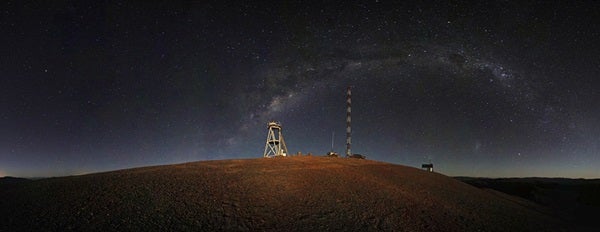On April 26, 2010, the European Southern Observatory Council (ESO) selected Cerro Armazones as the baseline site for the planned 42-meter European Extremely Large Telescope (E-ELT). Cerro Armazones is a mountain at an altitude of 10,000 feet (3,060 meters) in the central part of Chile’s Atacama Desert, and about 12 miles (20 kilometers) from Cerro Paranal, home of ESO’s Very Large Telescope.
“This is an important milestone that allows us to finalize the baseline design of this very ambitious project, which will vastly advance astronomical knowledge,” said Tim de Zeeuw, ESO’s director general. “I thank the site selection team for the tremendous work they have done over the past few years.”
ESO’s next step is to build the optical/infrared E-ELT with a primary mirror 138 feet (42 meters) in diameter. The E-ELT will be the world’s biggest eye on the sky — the only such telescope in the world. ESO is drawing up detailed construction plans together with the community. The E-ELT will address many of the most pressing unsolved questions in astronomy and may, eventually, revolutionize our perception of the universe, much as Galileo’s telescope did 400 years ago. The final go-ahead for construction is expected at the end of 2010 with the start of operations planned for 2018.
The ESO Council made the decision on the E-ELT site. The group is the governing body of the organization composed of representatives of ESO’s 14 member states. The choice was based on an extensive comparative meteorological investigation that lasted several years. The majority of the data collected during the site selection campaigns will be made public during this year.
Various factors needed to be considered in the site selection process. Obviously, the number of clear nights, the amount of water vapor, and the stability of the atmosphere (also known as seeing) played a crucial role. But other parameters had to be taken into account as well, such as the costs of construction and operations and the operational and scientific synergy with other major facilities (VLT/VLTI, VISTA, VST, ALMA, SKA, etc.).
In March 2010, the ESO Council was provided with a preliminary report with the main conclusions from the E-ELT Site Selection Advisory Committee. These conclusions confirmed that all the sites examined in the final shortlist (Armazones, Ventarrones, Tolonchar, and Vizcachas in Chile, and La Palma in Spain) have good conditions for astronomical observing, each one with its particular strengths. The technical report concluded that Cerro Armazones, near Paranal, stood out as the clearly preferred site because it has the best balance of sky quality for all the factors considered and can be operated in an integrated fashion with ESO’s Paranal Observatory. Cerro Armazones and Paranal share the same ideal conditions for astronomical observations. In particular, more than 320 nights are clear per year.
Taking into account the clear recommendation of the Site Selection Advisory Committee and all other relevant aspects, especially the scientific quality of the site, the ESO Council has now endorsed the choice of Cerro Armazones as the E-ELT baseline site.
“Adding the transformational scientific capabilities of the E-ELT to the already tremendously powerful integrated VLT observatory guarantees the long-term future of the Paranal as the most advanced optical/infrared observatory in the world and further strengthens ESO’s position as the world-leading organization for ground-based astronomy,” said de Zeeuw.
In anticipation of the choice of Cerro Armazones as the future site of the E-ELT and to facilitate and support the project, the Chilean government has agreed to donate to ESO a substantial tract of land contiguous to ESO’s Paranal property, which contains Armazones, in order to ensure the continued protection of the site against all adverse influences, in particular light pollution and mining activities.










